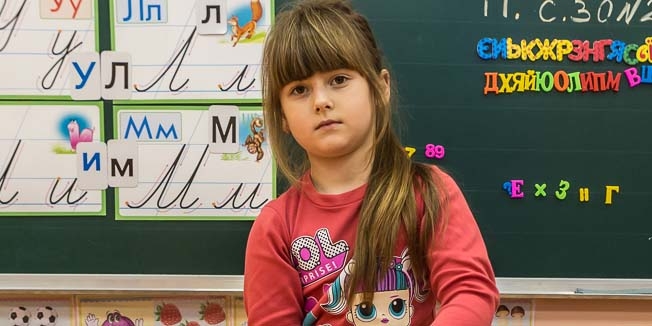
Six-year-old Olha* lives in a town on the frontline of the conflict in Eastern Ukraine.
How to Talk with Children About the Conflict in Ukraine
As hostilities in Ukraine escalate, children may see and hear things about the crisis in the news, leading to feelings of uncertainty, anxiety and fear, which parents and caregivers need to address, Save the Children’s psychologists warn.
Ane Lemche, a psychologist and child counselor with Save the Children, said children around the world might not fully understand what is happening in Ukraine and may have questions about the images, stories and conversations they are exposed to.
Previous Save the Children research in conflicts such as Iraq and Syria has revealed heartbreaking accounts of children terrified by the shelling and airstrikes, anxious about the future, and distraught at not being able to go to school. The majority of children showed signs of severe emotional distress.
“What is happening in Ukraine can be frightening for both children and adults. Ignoring or avoiding the topic can lead to children feeling lost, alone and more scared, which can affect their health and well-being. It is essential to have open and honest conversations with children to help them process what is happening,” said Lemche.
Below, experts at Save the Children share five tools and tips that caregivers can use to approach the conversation with children:
How and When to Talk About War and Conflict with Kids, According to Experts
1. Make time and listen when your child wants to talk
Give children the space to tell you what they know, how they feel, and to ask you questions. They may have formed a completely different picture of the situation than you have. Take the time to listen to what they think, and what they have seen or heard.
2. Tailor the conversation to the child
Be mindful of the child’s age as you approach the conversation with them. Young children may not understand what conflict or war means and require an age-appropriate explanation. Be careful not to over-explain the situation or go into too much detail as this can make children unnecessarily anxious. Younger children may be satisfied just by understanding that sometimes countries fight. Older children are more likely to understand what war means but may still benefit from talking with you about the situation. In fact, older children will often be more concerned by talk of war because they tend to understand the dangers better than younger children do.
3. Validate their feelings
It is important that children feel supported in the conversation. They should not feel judged or have their concerns dismissed. When children have the chance to have an open and honest conversation about things upsetting them, it can create a sense of relief and safety.
4. Reassure them that adults all over the world are working hard to resolve this
Remind children that this is not their problem to solve. They should not feel guilty about playing, seeing their friends, and doing the things that make them happy. Stay calm when you approach the conversation. Children often copy the sentiments of their caregivers—if you are uneasy about the situation, chances are your child will be uneasy as well.
5. Give them a practical way to help
Support children who want to help. Children who have the opportunity to help those affected by the conflict can feel like they are part of the solution. Children can create fundraisers, send letters to local decision-makers, or create drawings calling for peace.
